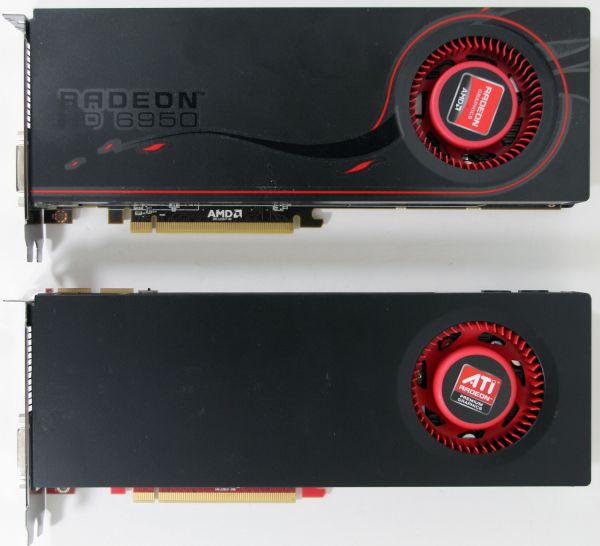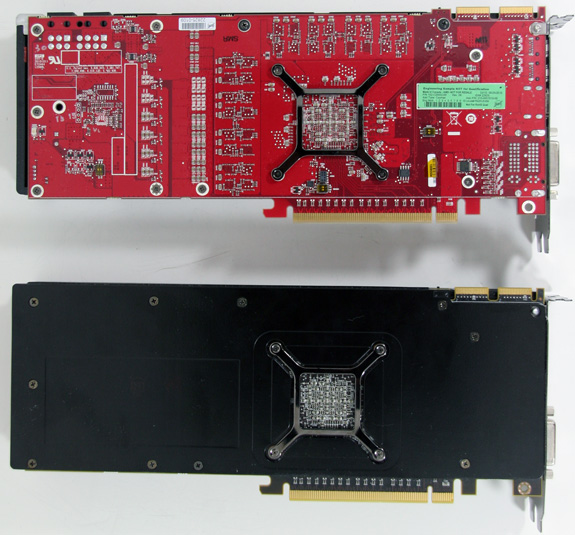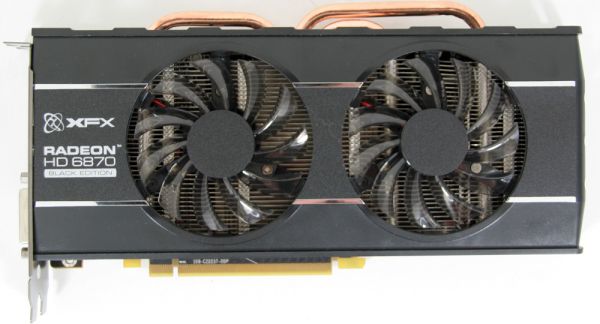AMD’s GTX 560 Ti Counter-Offensive: Radeon HD 6950 1GB & XFX’s Radeon HD 6870 Black Edition
by Ryan Smith on January 25, 2011 12:20 PM ESTMeet The Radeon HD 6950 1GB and XFX Radeon HD 6870 Black Edition
We’ll start our look at today’s cards with the headliner: AMD’s Radeon HD 6950 1GB. As we’ve previously established our 6950 is an engineering sample – perhaps an early one – so there’s not much to look at. Save for the kind of cosmetic defects you’d expect on an engineering sample, it’s for all practical purposes identical to the production 6950 2GB, and that’s intentional. AMD set out to make the 6950 1GB identical to the 6950 2GB other than the use of lower capacity GDDR5 chips, and this is what they have accomplished.

Top: 6950 2GB. Bottom: 6950 1GB Engineering Sample

Top: 6950 1GB Engineering Sample. Bottom: 6950 2GB
Since producing a 1GB card involves little more than replacing 2Gb memory chips with 1Gb memory chips, the true design innovations are going to come from AMD’s partners. Sapphire already has a 6950 1GB out with a custom cooler, and as AMD’s other partners get situated with 1GB cards we expect to see much of the same with them.
One item worth noting is that because our card is based on the reference design, it includes the BIOS switch at the top of the card. This means reference-based 1GB cards are going to have the same BIOS failsafe in them – however suitable BIOSes for the unlockers among you are another matter. Without some BIOS hacking (and possibly more), existing 6970 BIOSes are unsuitable as they’re meant for 2GB cards. Until such a time comes where a 6970 1GB BIOS can be developed, the 6950 1GB is not going to be a good card for unlocking. For the time being unlockers are going to want to stick to 2GB cards.
The Radeon HD 6950 1GB is launching with an MSRP of $259. At this time you can find reference-style 2GB cards for as little as $269, making the 1GB cards a rather simple $10 trade-off if you don’t mind mail-in rebates.
XFX Radeon HD 6870 Black Edition
Our second card of the day is XFX’s 2nd generation Radeon HD 6870 Black Edition (687A-ZDBC), the card that AMD originally proposed as the GTX 560 Ti’s competitor. Clocked at 940MHz core and 1150MHz (4.6Gbps data rate) memory, it runs at 40Mhz (4%) core and a 100MHz (9%) memory over the reference 6870. Overall this is a mild overclock, particularly as the 6870 is core-bound as opposed to memory-bound most of the time.
With such a mild overclock we had little reason to pay attention to the card, particularly once we completed our GTX 560 Ti benchmarking and saw that it was 10-20% faster than the stock-clocked 6870. Indeed it wasn’t until we tested the card that we saw something that grabbed our attention. Or perhaps I should say heard.
At the risk of spoiling the rest of our article, this card is for all practical purposes silent. At idle it’s only as loud as the noise floor of our GPU testbed, and at load – even under Furmark – it’s the same story. We measured 41.4dB at both idle and load, making it the quietest actively cooled mid-range card we have ever tested in our existing rig. Even the remarkably quiet GTX 460 can’t hold its ground to the 6870 Black Edition, it’s that quiet.
So what’s XFX’s secret? It’s much the same story as with the GTX 460. While the 6870 reference design uses a blower XFX is using an open-air cooler, specifically a double-fan cooler with 3 copper heatpipes that’s very similar to MSI’s Twin Frozor and Gigabyte’s Super Overclock cooler. Open-air coolers are already capable of being much quieter than blowers, and when done correctly a double-fan arrangement can be quieter than driving a single fan at higher speeds. Combining this highly effective cooler with the 6870’s Black Edition’s low TDP (~160W) results in a very quiet card that by all indications cannot be beaten at this point in time.
Rounding out the package, there are no real meaningful extras to discuss. Aside from some trinkets (stickers, case badges, etc), the only other piece of hardware in the box is a short CrossFire bridge. XFX has kept it simple: the only things that really matter are the card and XFX’s lifetime warranty.
The Radeon HD 6870 Black Edition doesn’t have a set MSRP, but it’s currently available for around $229 with a mail-in rebate, making it roughly $10 more expensive than a stock-clocked card. Or compared to XFX’s lineup, the non-Black Edition version of this card is a mere $4 less at $225; so you’re looking at a $4 factory overclock and $6 for a supurb custom cooler.












111 Comments
View All Comments
7Enigma - Tuesday, January 25, 2011 - link
Here's the point. There is no measurable difference with it on or not from a framerate perspective. So in this case it doesn't matter. That should tell you that the only possible difference in this instance would be a possible WORSENING of picture quality since the GPU wars are #1 about framerate and #2 about everything else. I'm sure a later article will delve into what the purpose of this setting is for but right now it clearly has no benefit from the test suite that was chosen.I agree with you though that I would have liked a slightly more detailed description of what it is supposed to do...
For instance is there any power consumption (and thus noise) differences with it on vs. off?
Ryan Smith - Tuesday, January 25, 2011 - link
For the time being it's necessary that we use Use Application Setting so that newer results are consistent with our existing body of work. As this feature did not exist prior to to the 11.1a drivers, using it would impact our results by changing the test parameters - previously it wasn't possible to cap tessellation factors like this so we didn't run our tests with such a limitation.As we rebuild our benchmark suite every 6 months, everything is up for reevaluation at that time. We may or may not continue to disable this feature, but for the time being it's necessary for consistent testing.
Dark Heretic - Wednesday, January 26, 2011 - link
Thanks for the reply Ryan, that's a very valid point on keeping the testing parameters consistent with current benchmark results.Would it be possible to actually leave the drivers at default settings for both Nvidia and AMD in the next benchmark suite. I know there will be some inconsistent variations between both sets of drivers, but it would allow for a more accurate picture on both hardware and driver level (as intended by Nvidia / AMD when setting defaults)
I use both Nvidia and AMD cards, and do find differences between picture quality / performances from both sides of the fence. However i also tend to leave drivers at default settings to allow both Nvidia and AMD the benefit of knowing what works best with their hardware on a driver level, i think it would allow for a more "real world" set of benchmark results.
@B3an, perhaps you should have used the phrase "lacking in cognitive function", it's much more polite. You'll have to forgive the oversight of not thinking about the current set of benchmarks overall as Ryan has politely pointed out.
B3an - Wednesday, January 26, 2011 - link
You post is simply retarded for lack of a better word.Ryan is completely right in disabling this feature, even though it has no effect on the results (yet) in the current drivers. And it should always be disabled in the future.
The WHOLE point of articles like this is to get the results as fair as possible. If you're testing a game and it looks different and uses different settings on one card to another, how is that remotely fair? What is wrong with you?? Bizarre logic.
It would be the exact same thing as if AMD was to disable AA by default in all games even if the game settings was set to use AA, and then having the nVidia card use AA in the game tests while the AMD card did not. The results would be absolutely useless, no one would know which card is actually faster.
prdola0 - Thursday, January 27, 2011 - link
Exactly. We should compare apples-to-apples. And let's not forget about the FP16 Demotion "optimization" in the AMD drivers that reduces the render target width from R16G16B16A16 to R11G11B10, effectively reducing bandwidth from 64bits to 32bits at the expense of quality. All this when the Catalyst AI is turned on. AMD claims it doesn't have any effect on the quality, but multiple sources already confirmed that it is easily visible without much effort in some titles, while in some others it doesn't have. However it affects performance for up to 17%. Just google "fp16 demotion" and you will see a plenty of articles about it.burner1980 - Tuesday, January 25, 2011 - link
Thanks for not listening to your readers.Why do you have to include an apple to orange comparison again ?
Is it so hard to test Non-OC vs Non-OC and Oc vs. OC ?
The article itself is fine, but please stop this practice.
Proposal for an other review: Compare ALL current factory stock graphic card models with their highest "reasonable" overclock against each other. Which valus does the customer get when taking OC into (buying) consideration ?
james.jwb - Tuesday, January 25, 2011 - link
quite a good idea if done correctly. Sort of 460's and above would be nice to see.AnnonymousCoward - Thursday, January 27, 2011 - link
Apparently the model number is very important to you. What if every card above 1MHz was called OC? Then you wouldn't want to consider them. But the 6970@880MHz and 6950@800MHz are fine! Maybe you should focus on price, performance, and power, instead of the model name or color of the plastic.I'm going to start my own comments complaint campaign: Don't review cards that contain any blue in the plastic! Apples to apples, people.
AmdInside - Tuesday, January 25, 2011 - link
Can someone tell me where to find a 6950 for ~$279? Sorry but after rebates do not count.Spoelie - Tuesday, January 25, 2011 - link
If you look at the numbers, the 6870BE is more of a competitor than the article text would make you believe - in the games where the nvidia cards do not completely trounce the competition.Look at the 1920x1200 charts of the following games and tell me the 6870BE is outclassed:
*crysis warhead
*metro
*battlefield (except waterfall? what is the point of that benchmark btw)
*stalker
*mass effect2
*wolfenstein
If you now look at the remaining games where the NVIDIA card owns:
*hawx (rather inconsequential at these framerates)
*civ5
*battleforge
*dirt2
You'll notice in those games that the 6950 is just as outclassed. So you're better of with an nvidia card either way.
It all depends on the games that you pick, but a blanket statement that 6870BE does not compete is not correct either.